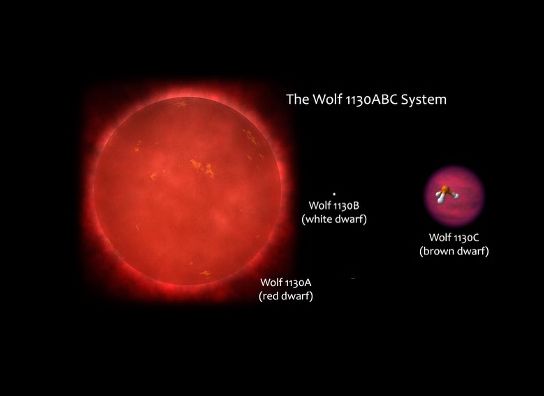Astronomers detect explosive, toxic gas in ancient brown dwarf
Posted on: 03 October 2025
Astronomers have detected the explosive, highly toxic gas phosphine (PH3), in the atmosphere of an ancient brown dwarf (Wolf 1130C) located 54 light-years from the Sun in the constellation Cygnus. Phosphine has long been recognised as a possible biosignature for anaerobic life, given that there are few natural sources in terrestrial planet atmospheres.
Phosphine is formed when phosphorus – one of six key elements necessary for life on Earth – combines with hydrogen. On Earth, phosphine is a byproduct of decaying organic swamp matter, while it is also found in the atmospheres of Jupiter and Saturn.
But its relative rarity in other brown dwarf atmospheres continues to baffle.

The team of researchers behind the phosphine—Wolf 1130C discovery, led by University of California San Diego Professor of Astronomy and Astrophysics Adam Burgasser, report their landmark findings today in leading international journal Science.
Phosphine was detected in Wolf 1130C’s atmosphere using observations obtained with the James Webb Space Telescope (JWST), the first telescope with the sensitivity to look at these celestial objects in detail. The mystery, however, is not why phosphine was found, but why it’s missing in other brown dwarf and gas giant exoplanet atmospheres.
“Prior to JWST, phosphine was expected to be abundant in exoplanet and brown dwarf atmospheres, following theoretical predictions based on the turbulent mixing we know exists in these sources,” said co-author Sam Beiler, who recently graduated and is now postdoctoral scholar in Trinity’s School of Physics where he has joined a group led by Prof. Johanna Vos.
Beiler, who led previous work studying the lack of phosphine in brown dwarfs, added: “Every observation we've obtained with JWST has challenged the theoretical predictions. That is, until we observed Wolf 1130C.”
Unlike other brown dwarfs, the team easily spotted phosphine in JWST’s infrared spectral data of Wolf 1130C. While the researchers are delighted by their discovery, it raises an issue: why this brown dwarf, and not others? One possibility is the low abundance of metals – essentially any elements other than hydrogen and helium – in Wolf 1130C’s atmosphere, which may change its underlying chemistry.
“It may be that in normal conditions phosphorus is bound up in another molecule such as phosphorus trioxide,” explained Beiler. “In the metal-depleted atmosphere of Wolf 1130C, there isn’t enough oxygen to take up the phosphorus, allowing phosphine to form from the abundant hydrogen.”
Understanding why this one brown dwarf shows a clear signature of phosphine may lead to new insights into the synthesis of phosphorus in the Milky Way and its chemistry in planetary atmospheres. Explained Prof. Burgasser: “Understanding phosphine chemistry in the atmospheres of brown dwarfs where we don’t expect life is crucial if we hope to use this molecule in the search for life on terrestrial worlds beyond our solar system.”
This study was funded in part by NASA/STScI (NAS 5-03127 and AR-2232) and the Heising-Simons Foundation.
Image: Schematic of the Wolf 1130ABC triple system, composed of the red dwarf star Wolf 1130A, its close and compact white dwarf companion Wolf 1130B, and the distant brown dwarf tertiary Wolf 1130C. The three components of this system are scaled to their relative sizes. Image credit: Adam Burgasser.
Media Contact:
Thomas Deane | Media Relations | deaneth@tcd.ie | +353 1 896 4685
